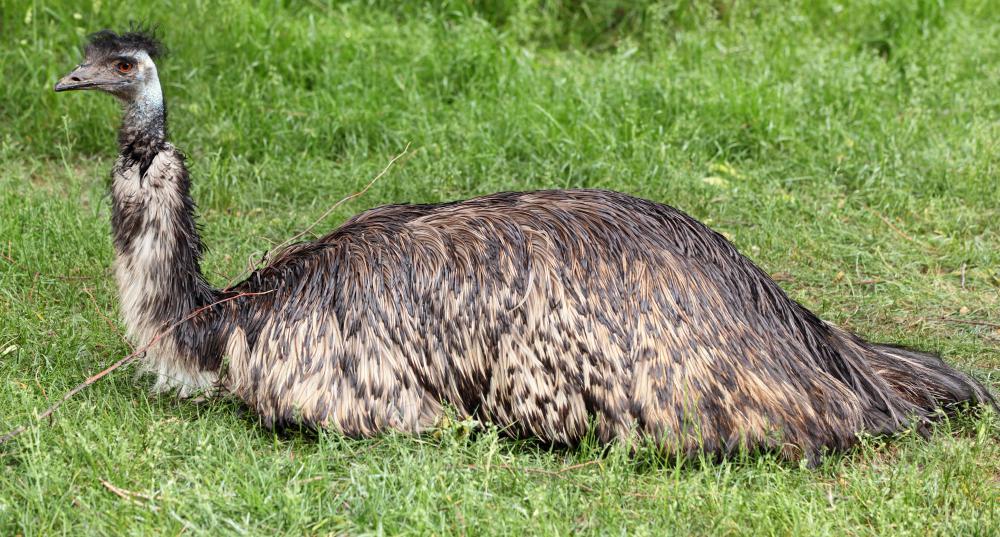At AllThingsNature, we're committed to delivering accurate, trustworthy information. Our expert-authored content is rigorously fact-checked and sourced from credible authorities. Discover how we uphold the highest standards in providing you with reliable knowledge.
What is an Emu?
The emu, Dromaius novaehollandiae is a large, flightless bird native to Australia. It is the largest bird on the continent, and the second largest in the world, after the ostrich. Together with the Australian cassowary, these giant birds make up the avian family Casuarriidae.
The largest specimens of emus can reach up to six and a half feet in height (2 m) and usually weigh about 66-121 lbs (30-55 kg.) They are exceptionally fast runners, able to reach speeds exceeding 30 miles per hour (50 kmh) and maintain that speed for some time. Their stride may be as much as nine ft (2.7) in length. They have a long neck and large three-toed feet, and are strong swimmers.

Emus have an excellent biological adaptation for dealing with the heat of Australia. The long, shaggy coat of the birds absorbs solar radiation, effectively insulating the bird from the heat. This allows them to remain active during the day, an important factor of survival in the extreme heat of the outback. During hot weather, the bird can also pant, using its lungs as a cooling mechanism for its body.

During mating season, emus form temporary mating pairs, remaining together for five or six months. In May and June, the female lays several eggs every few days that are roughly ten times as large as chicken eggs. The male incubates the eggs exclusively, while a female emu may mate with other males after her initial laying is complete. Males do not eat or drink during incubation, and do not leave the nest. After two months, hatching occurs and the chicks are cared for by the adult male birds.

Hatchlings mature in approximately one year, and often stay with their fathers for 18 months. The lifespan of wild emus is 10-20 years, although captive specimens have been known to live nearly twice as long. Hatchlings have provided researches with the only evidence of identical twins among birds, although studies suggest this are exceptionally rare.
Aboriginal cultures have long hunted the emu for its coat, meat and supposed medicinal properties. In the late 20th century, commercial raising of the birds for meat and leather began in Australia, North America and China. The popularity of the meat is believed to be due to its low fat content and gamey flavor. Emu burgers are now popular items at some restaurants.
In Aboriginal mythology, the sun is said to have been created by an emu egg being thrown into the sky. Throughout Australia, about 600 towns, lakes and landmarks have been named for the birds, and an Australian company even markets a line of Emu beers. It is a popular symbol of Australian culture and a beloved mascot of the country.
A Tasmanian subspecies of the bird is believed to have become extinct in the mid 19th century, but Australian populations of the bird are relatively stable. The emu’s success in the wild is attributed to its large reproductive rate and well-adapted behaviors. Still, the birds can be threatened by common Australian wildfires and human encroachment on natural ranges. For the moment, the emu maintains a thriving population.
Frequently Asked Questions
What is an emu, and where can it be found?
An emu is the second-largest living bird by height, native to Australia. It is a flightless bird, belonging to the ratite family, which includes ostriches and kiwis. Emus are adaptable to various Australian ecosystems, from coastal regions to arid desert areas. They play a significant role in the ecological balance, dispersing seeds and contributing to vegetation growth.
How tall can an emu grow, and what does it weigh?
Emus can reach up to 6 feet in height and weigh between 90 to 120 pounds. Their size is a distinctive feature, making them the largest bird native to Australia. Despite their large size, emus are fast runners, capable of reaching speeds up to 30 miles per hour, which helps them evade predators and cover large distances in search of food.
What do emus typically eat?
Emus are omnivores with a diet that includes a variety of plants, insects, and small vertebrates. They consume seeds, fruits, flowers, and shoots, as well as insects like grasshoppers and beetles. Their foraging behavior contributes to their role as seed dispersers, aiding in the propagation of plant species across their habitats.
How do emus reproduce, and what is unique about their breeding behavior?
Emus have a unique breeding behavior where the male becomes the primary caregiver. After the female lays her eggs, the male incubates them for about eight weeks without eating, drinking, or defecating. Once hatched, the male continues to protect and rear the chicks for up to 18 months, teaching them essential survival skills.
Are emus endangered, and what threats do they face?
Emus are currently not endangered and are listed as a species of 'Least Concern' by the International Union for Conservation of Nature (IUCN). However, they face threats from habitat loss due to agricultural development, collisions with vehicles, and predation by introduced species like foxes and feral cats, especially in areas where their natural habitat has been fragmented.
Can emus be domesticated, and are they farmed for any purpose?
Emus can be farmed, and while they are not typically domesticated in the same way as dogs or cats, they are raised for their meat, oil, and leather. Emu farming has become an industry, particularly in Australia and the United States. Emu oil is used for its anti-inflammatory properties, and the lean red meat is considered a healthy alternative to beef.
AS FEATURED ON:
AS FEATURED ON:













Discuss this Article
Post your comments